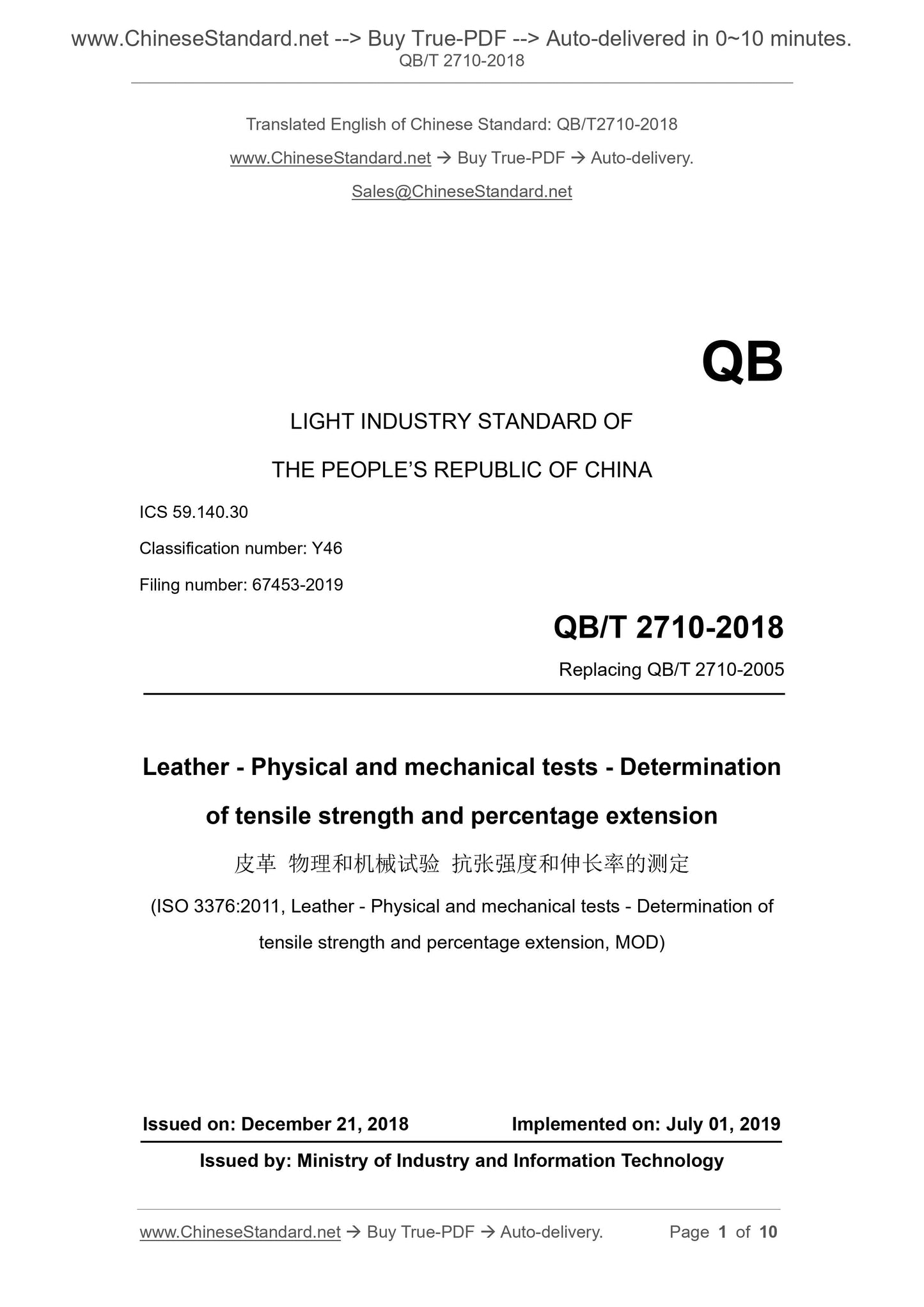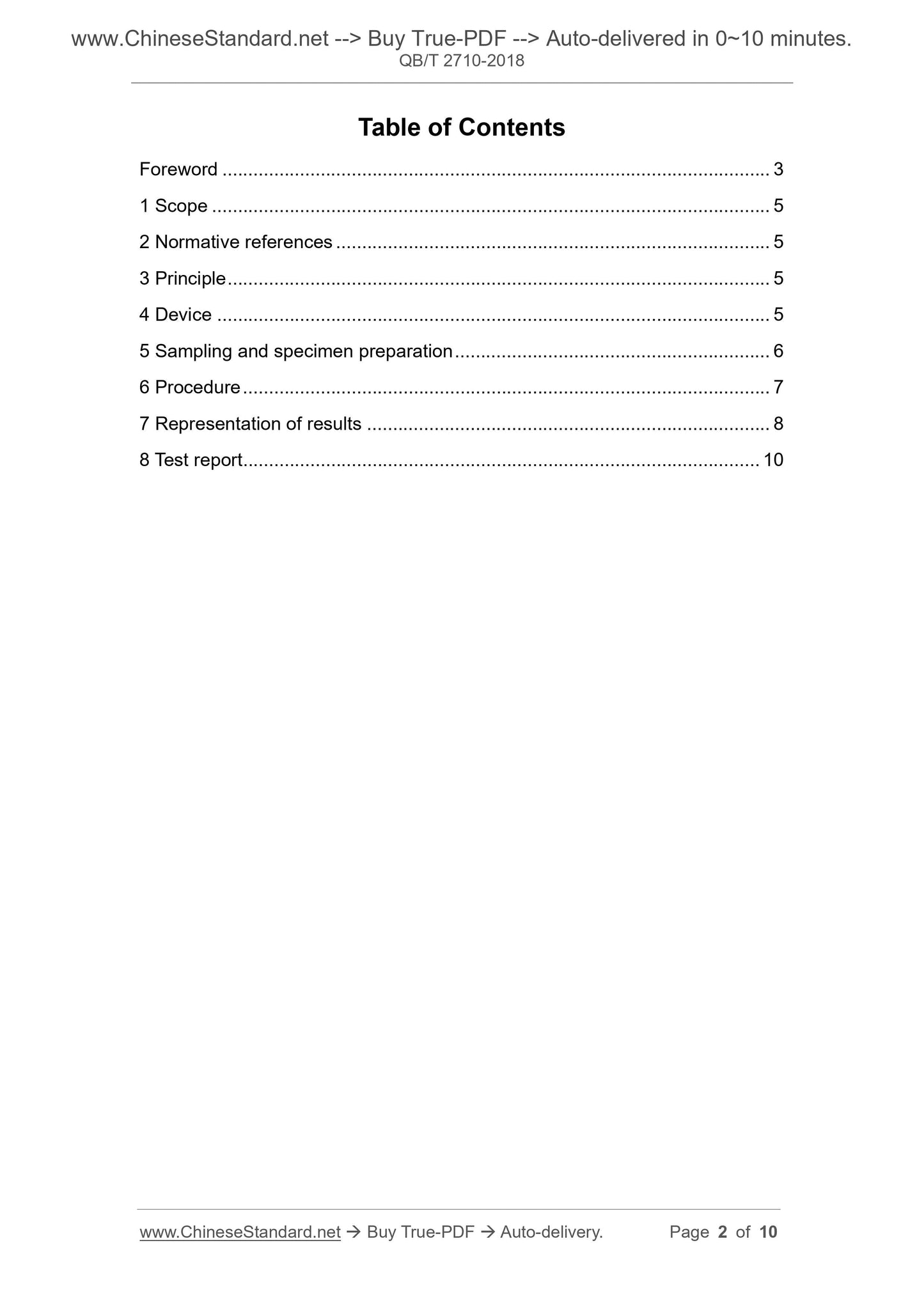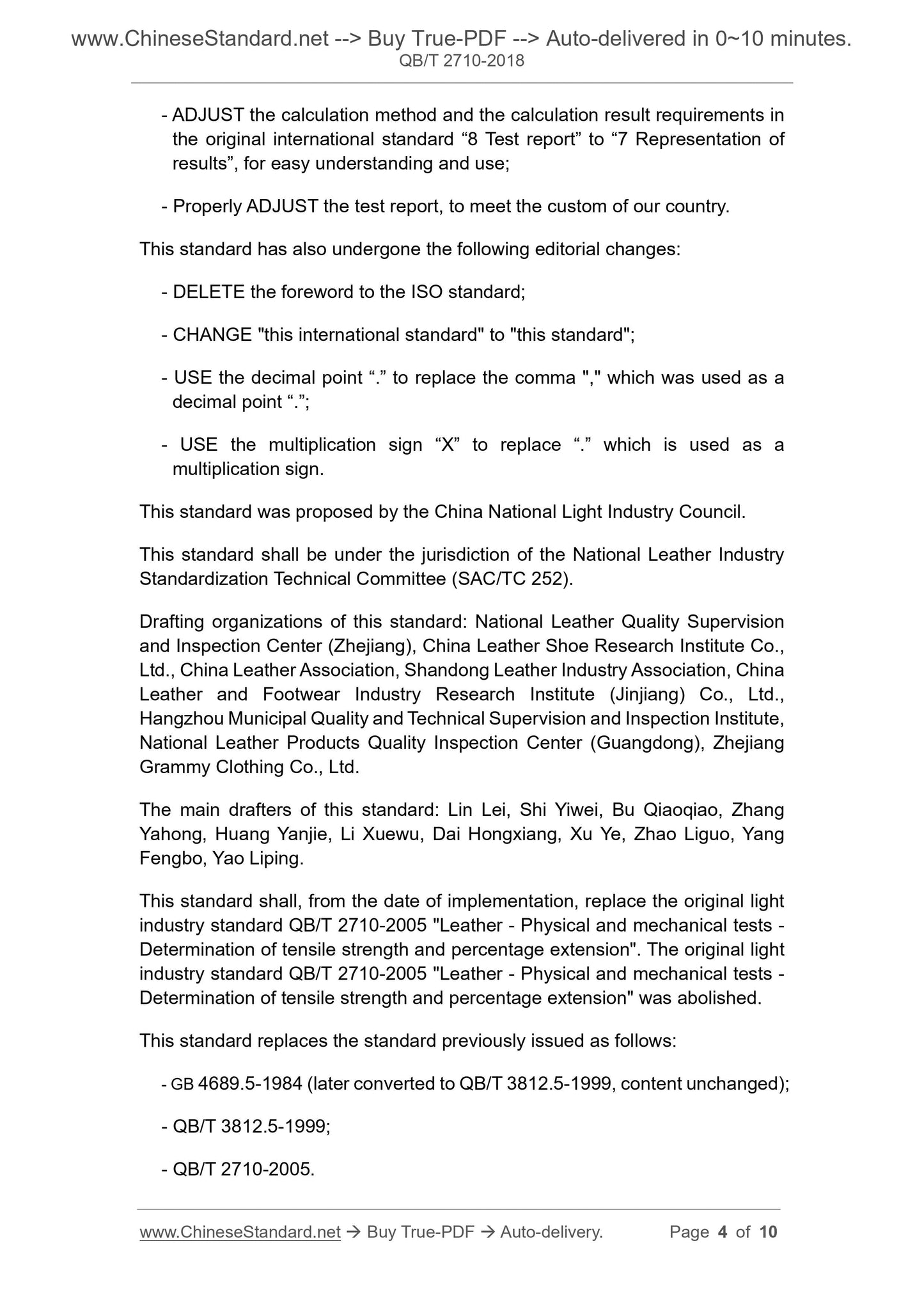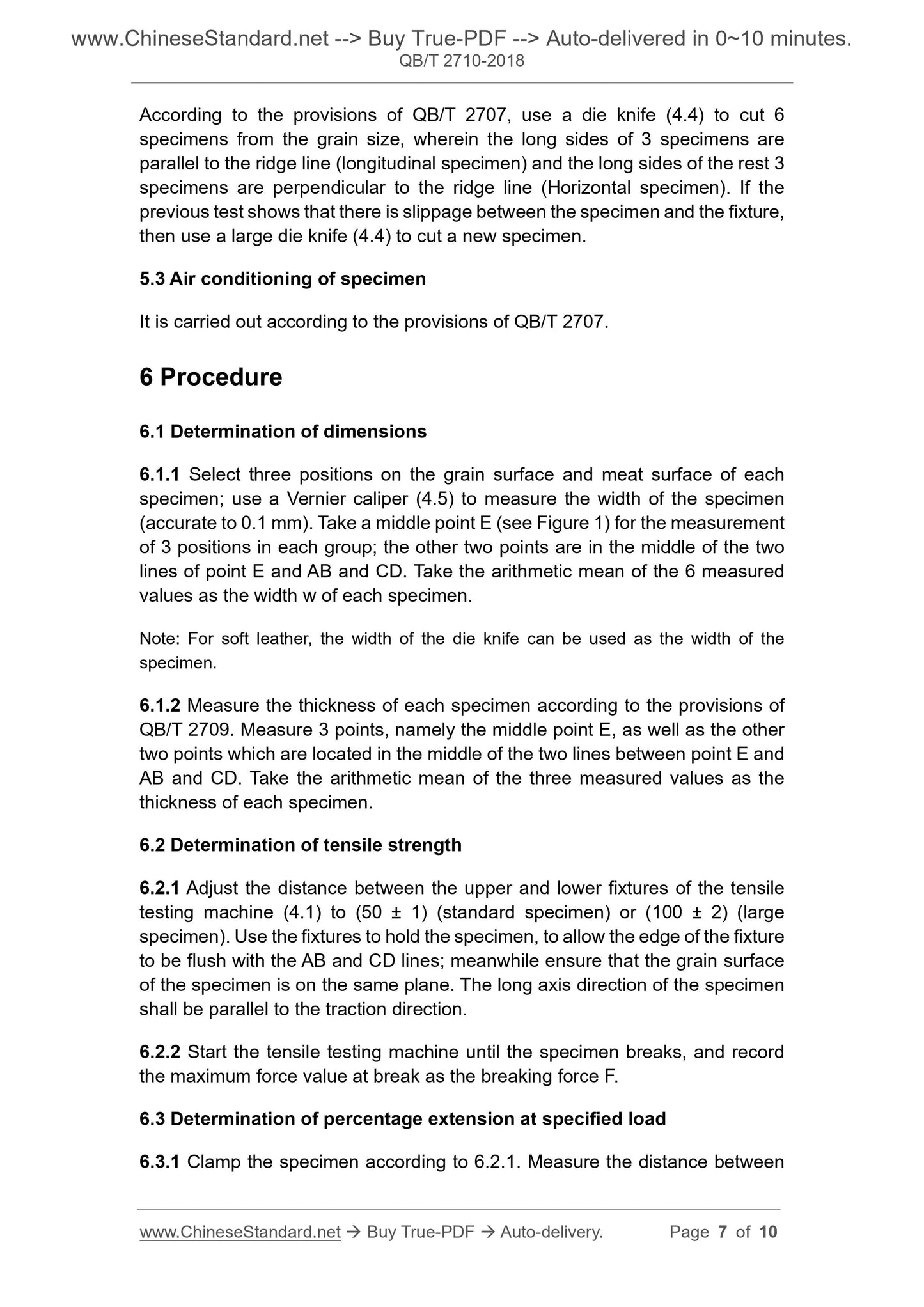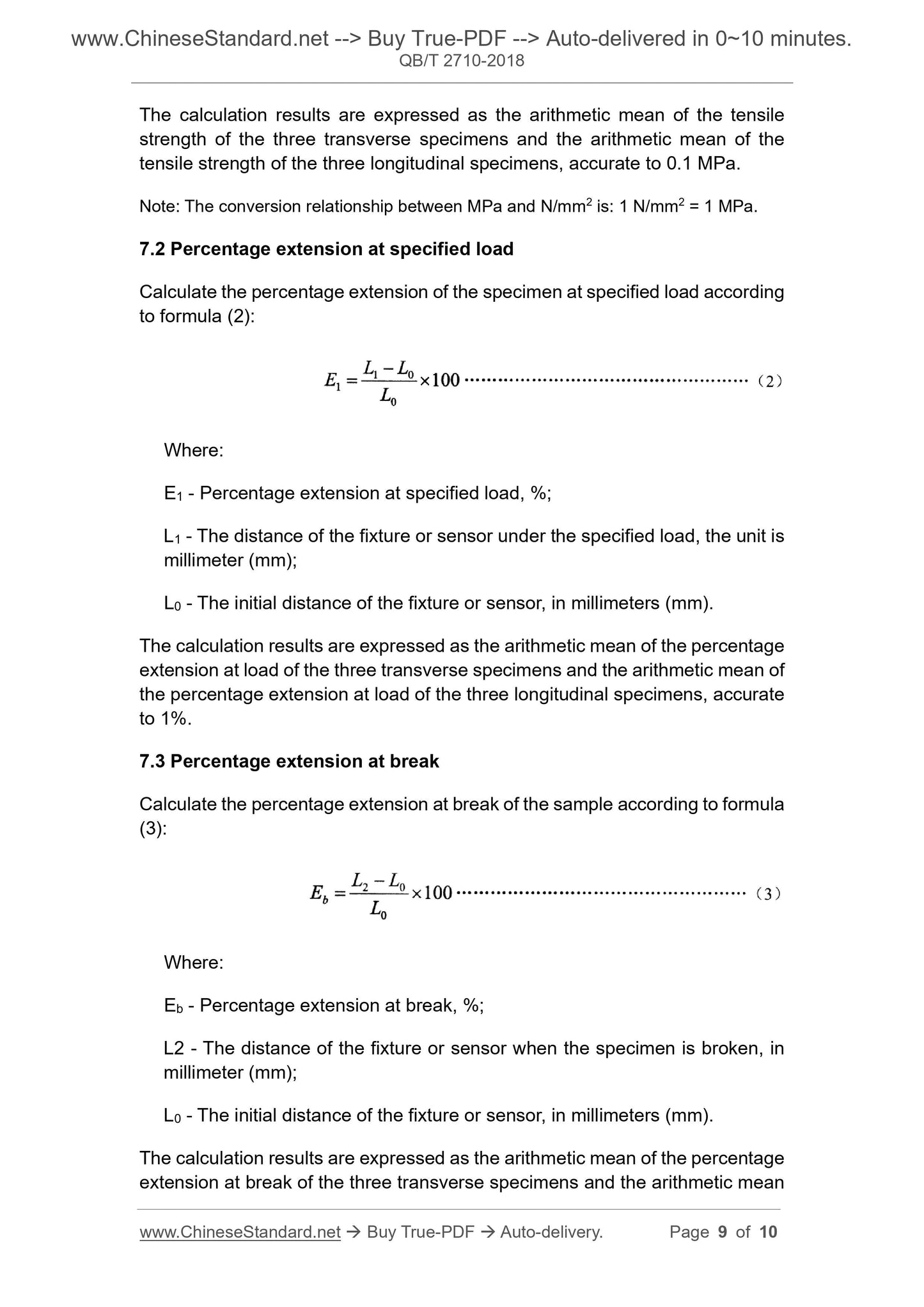1
/
of
5
PayPal, credit cards. Download editable-PDF and invoice in 1 second!
QB/T 2710-2018 English PDF (QBT2710-2018)
QB/T 2710-2018 English PDF (QBT2710-2018)
Regular price
$115.00 USD
Regular price
Sale price
$115.00 USD
Unit price
/
per
Shipping calculated at checkout.
Couldn't load pickup availability
Delivery: 3 seconds. Download true-PDF + Invoice.
Get QUOTATION in 1-minute: Click QB/T 2710-2018
Historical versions: QB/T 2710-2018
Preview True-PDF (Reload/Scroll if blank)
QB/T 2710-2018: Leather -- Physical and mechanical tests -- Determination of tensile strength and percentage extension
QB/T 2710-2018
LIGHT INDUSTRY STANDARD OF
THE PEOPLE’S REPUBLIC OF CHINA
ICS 59.140.30
Classification number. Y46
Filing number. 67453-2019
Replacing QB/T 2710-2005
Leather - Physical and mechanical tests - Determination
of tensile strength and percentage extension
(ISO 3376.2011, Leather - Physical and mechanical tests - Determination of
tensile strength and percentage extension, MOD)
ISSUED ON. DECEMBER 21, 2018
IMPLEMENTED ON. JULY 01, 2019
Issued by. Ministry of Industry and Information Technology
Table of Contents
Foreword... 3
1 Scope... 5
2 Normative references... 5
3 Principle... 5
4 Device... 5
5 Sampling and specimen preparation... 6
6 Procedure... 7
7 Representation of results... 8
8 Test report... 10
- ADJUST the calculation method and the calculation result requirements in
the original international standard “8 Test report” to “7 Representation of
results”, for easy understanding and use;
- Properly ADJUST the test report, to meet the custom of our country.
This standard has also undergone the following editorial changes.
- DELETE the foreword to the ISO standard;
- CHANGE "this international standard" to "this standard";
- USE the decimal point “.” to replace the comma "," which was used as a
decimal point “.”;
- USE the multiplication sign “X” to replace “.” which is used as a
multiplication sign.
This standard was proposed by the China National Light Industry Council.
This standard shall be under the jurisdiction of the National Leather Industry
Standardization Technical Committee (SAC/TC 252).
Drafting organizations of this standard. National Leather Quality Supervision
and Inspection Center (Zhejiang), China Leather Shoe Research Institute Co.,
Ltd., China Leather Association, Shandong Leather Industry Association, China
Leather and Footwear Industry Research Institute (Jinjiang) Co., Ltd.,
Hangzhou Municipal Quality and Technical Supervision and Inspection Institute,
National Leather Products Quality Inspection Center (Guangdong), Zhejiang
Grammy Clothing Co., Ltd.
The main drafters of this standard. Lin Lei, Shi Yiwei, Bu Qiaoqiao, Zhang
Yahong, Huang Yanjie, Li Xuewu, Dai Hongxiang, Xu Ye, Zhao Liguo, Yang
Fengbo, Yao Liping.
This standard shall, from the date of implementation, replace the original light
industry standard QB/T 2710-2005 "Leather - Physical and mechanical tests -
Determination of tensile strength and percentage extension". The original light
industry standard QB/T 2710-2005 "Leather - Physical and mechanical tests -
Determination of tensile strength and percentage extension" was abolished.
This standard replaces the standard previously issued as follows.
- GB 4689.5-1984 (later converted to QB/T 3812.5-1999, content unchanged);
- QB/T 3812.5-1999;
- QB/T 2710-2005.
According to the provisions of QB/T 2707, use a die knife (4.4) to cut 6
specimens from the grain size, wherein the long sides of 3 specimens are
parallel to the ridge line (longitudinal specimen) and the long sides of the rest 3
specimens are perpendicular to the ridge line (Horizontal specimen). If the
previous test shows that there is slippage between the specimen and the fixture,
then use a large die knife (4.4) to cut a new specimen.
5.3 Air conditioning of specimen
It is carried out according to the provisions of QB/T 2707.
6 Procedure
6.1 Determination of dimensions
6.1.1 Select three positions on the grain surface and meat surface of each
specimen; use a Vernier caliper (4.5) to measure the width of the specimen
(accurate to 0.1 mm). Take a middle point E (see Figure 1) for the measurement
of 3 positions in each group; the other two points are in the middle of the two
lines of point E and AB and CD. Take the arithmetic mean of the 6 measured
values as the width w of each specimen.
Note. For soft leather, the width of the die knife can be used as the width of the
specimen.
6.1.2 Measure the thickness of each specimen according to the provisions of
QB/T 2709.Measure 3 points, namely the middle point E, as well as the other
two points which are located in the middle of the two lines between point E and
AB and CD. Take the arithmetic mean of the three measured values as the
thickness of each specimen.
6.2 Determination of tensile strength
6.2.1 Adjust the distance between the upper and lower fixtures of the tensile
testing machine (4.1) to (50 ± 1) (standard specimen) or (100 ± 2) (large
specimen). Use the fixtures to hold the specimen, to allow the edge of the fixture
to be flush with the AB and CD lines; meanwhile ensure that the grain surface
of the specimen is on the same plane. The long axis direction of the specimen
shall be parallel to the traction direction.
6.2.2 Start the tensile testing machine until the specimen breaks, and record
the maximum force value at break as the breaking force F.
6.3 Determination of percentage extension at specified load
6.3.1 Clamp the specimen according to 6.2.1.Measure the distance between
The calculation results are expressed as the arithmetic mean of the tensile
strength of the three transverse specimens and the arithmetic mean of the
tensile strength of the three longitudinal specimens, accurate to 0.1 MPa.
Note. The conversion relationship between MPa and N/mm2 is. 1 N/mm2 = 1 MPa.
7.2 Percentage extension at specified load
Calculate the percentage extension of the specimen at specified load according
to formula (2).
Where.
E1 - Percentage extension at specified load, %;
L1 - The distance of the fixture or sensor under the specified load, the unit is
millimeter (mm);
L0 - The initial distance of the fixture or sensor, in millimeters (mm).
The calculation results are expressed as the arithmetic mean of the percentage
extension at load of the three transverse specimens and the arithmetic mean of
the percentage extension at load of the three longitudinal specimens, accurate
to 1%.
7.3 Percentage extension at break
Calculate the percentage extension at break of the sample according to formula
(3).
Where.
Eb - Percentage extension at break, %;
L2 - The distance of the fixture or sensor when the specimen is broken, in
millimeter (mm);
L0 - The initial distance of the fixture or sensor, in millimeters (mm).
The calculation results are expressed as the arithmetic mean of the percentage
extension at break of the three transverse specimens and the arithmetic mean
Get QUOTATION in 1-minute: Click QB/T 2710-2018
Historical versions: QB/T 2710-2018
Preview True-PDF (Reload/Scroll if blank)
QB/T 2710-2018: Leather -- Physical and mechanical tests -- Determination of tensile strength and percentage extension
QB/T 2710-2018
LIGHT INDUSTRY STANDARD OF
THE PEOPLE’S REPUBLIC OF CHINA
ICS 59.140.30
Classification number. Y46
Filing number. 67453-2019
Replacing QB/T 2710-2005
Leather - Physical and mechanical tests - Determination
of tensile strength and percentage extension
(ISO 3376.2011, Leather - Physical and mechanical tests - Determination of
tensile strength and percentage extension, MOD)
ISSUED ON. DECEMBER 21, 2018
IMPLEMENTED ON. JULY 01, 2019
Issued by. Ministry of Industry and Information Technology
Table of Contents
Foreword... 3
1 Scope... 5
2 Normative references... 5
3 Principle... 5
4 Device... 5
5 Sampling and specimen preparation... 6
6 Procedure... 7
7 Representation of results... 8
8 Test report... 10
- ADJUST the calculation method and the calculation result requirements in
the original international standard “8 Test report” to “7 Representation of
results”, for easy understanding and use;
- Properly ADJUST the test report, to meet the custom of our country.
This standard has also undergone the following editorial changes.
- DELETE the foreword to the ISO standard;
- CHANGE "this international standard" to "this standard";
- USE the decimal point “.” to replace the comma "," which was used as a
decimal point “.”;
- USE the multiplication sign “X” to replace “.” which is used as a
multiplication sign.
This standard was proposed by the China National Light Industry Council.
This standard shall be under the jurisdiction of the National Leather Industry
Standardization Technical Committee (SAC/TC 252).
Drafting organizations of this standard. National Leather Quality Supervision
and Inspection Center (Zhejiang), China Leather Shoe Research Institute Co.,
Ltd., China Leather Association, Shandong Leather Industry Association, China
Leather and Footwear Industry Research Institute (Jinjiang) Co., Ltd.,
Hangzhou Municipal Quality and Technical Supervision and Inspection Institute,
National Leather Products Quality Inspection Center (Guangdong), Zhejiang
Grammy Clothing Co., Ltd.
The main drafters of this standard. Lin Lei, Shi Yiwei, Bu Qiaoqiao, Zhang
Yahong, Huang Yanjie, Li Xuewu, Dai Hongxiang, Xu Ye, Zhao Liguo, Yang
Fengbo, Yao Liping.
This standard shall, from the date of implementation, replace the original light
industry standard QB/T 2710-2005 "Leather - Physical and mechanical tests -
Determination of tensile strength and percentage extension". The original light
industry standard QB/T 2710-2005 "Leather - Physical and mechanical tests -
Determination of tensile strength and percentage extension" was abolished.
This standard replaces the standard previously issued as follows.
- GB 4689.5-1984 (later converted to QB/T 3812.5-1999, content unchanged);
- QB/T 3812.5-1999;
- QB/T 2710-2005.
According to the provisions of QB/T 2707, use a die knife (4.4) to cut 6
specimens from the grain size, wherein the long sides of 3 specimens are
parallel to the ridge line (longitudinal specimen) and the long sides of the rest 3
specimens are perpendicular to the ridge line (Horizontal specimen). If the
previous test shows that there is slippage between the specimen and the fixture,
then use a large die knife (4.4) to cut a new specimen.
5.3 Air conditioning of specimen
It is carried out according to the provisions of QB/T 2707.
6 Procedure
6.1 Determination of dimensions
6.1.1 Select three positions on the grain surface and meat surface of each
specimen; use a Vernier caliper (4.5) to measure the width of the specimen
(accurate to 0.1 mm). Take a middle point E (see Figure 1) for the measurement
of 3 positions in each group; the other two points are in the middle of the two
lines of point E and AB and CD. Take the arithmetic mean of the 6 measured
values as the width w of each specimen.
Note. For soft leather, the width of the die knife can be used as the width of the
specimen.
6.1.2 Measure the thickness of each specimen according to the provisions of
QB/T 2709.Measure 3 points, namely the middle point E, as well as the other
two points which are located in the middle of the two lines between point E and
AB and CD. Take the arithmetic mean of the three measured values as the
thickness of each specimen.
6.2 Determination of tensile strength
6.2.1 Adjust the distance between the upper and lower fixtures of the tensile
testing machine (4.1) to (50 ± 1) (standard specimen) or (100 ± 2) (large
specimen). Use the fixtures to hold the specimen, to allow the edge of the fixture
to be flush with the AB and CD lines; meanwhile ensure that the grain surface
of the specimen is on the same plane. The long axis direction of the specimen
shall be parallel to the traction direction.
6.2.2 Start the tensile testing machine until the specimen breaks, and record
the maximum force value at break as the breaking force F.
6.3 Determination of percentage extension at specified load
6.3.1 Clamp the specimen according to 6.2.1.Measure the distance between
The calculation results are expressed as the arithmetic mean of the tensile
strength of the three transverse specimens and the arithmetic mean of the
tensile strength of the three longitudinal specimens, accurate to 0.1 MPa.
Note. The conversion relationship between MPa and N/mm2 is. 1 N/mm2 = 1 MPa.
7.2 Percentage extension at specified load
Calculate the percentage extension of the specimen at specified load according
to formula (2).
Where.
E1 - Percentage extension at specified load, %;
L1 - The distance of the fixture or sensor under the specified load, the unit is
millimeter (mm);
L0 - The initial distance of the fixture or sensor, in millimeters (mm).
The calculation results are expressed as the arithmetic mean of the percentage
extension at load of the three transverse specimens and the arithmetic mean of
the percentage extension at load of the three longitudinal specimens, accurate
to 1%.
7.3 Percentage extension at break
Calculate the percentage extension at break of the sample according to formula
(3).
Where.
Eb - Percentage extension at break, %;
L2 - The distance of the fixture or sensor when the specimen is broken, in
millimeter (mm);
L0 - The initial distance of the fixture or sensor, in millimeters (mm).
The calculation results are expressed as the arithmetic mean of the percentage
extension at break of the three transverse specimens and the arithmetic mean
Share
